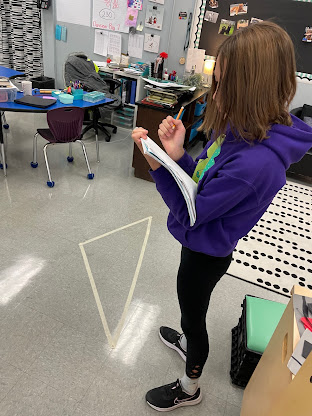Math:
I can identify and plot points in the first quadrant of a Cartesian plane, using whole number ordered pairs.
I can perform and describe single transformations of a 2-D shape in the first quadrant of a Cartesian plane.
I can perform a combination of translations, rotations and/or reflections on a single 2-D shape, and draw and describe the image.
I can perform a combination of successive transformations of 2-D shapes to create a design, and identify and describe the transformations.
We started by reviewing the elements of a cartesian plane. Even though there are four quadrants, in grade six, we only deal with the first quadrant. We learned that the vertical axis is labeled with a Y and the horizontal axis is labeled with an X. Ordered pairs are written (X,Y) and we remember to run (move along the x axis) then jump (move up the y axis) when plotting points on the cartesian plane. Students practiced plotting and identifying points by playing Cartesian Plane Battleship.

After students mastered plotting and identifying points, we moved onto plotting 2D shapes on the cartesian plane. Students learned how to make sure all the vertices of each shape land on the intersection of a X and Y axis, and how to label their shapes. Drawing and labeling shapes on a cartesian plane requires precision so we practiced taking our time, using a ruler, and writing clear labels. After practicing with some triangles, students drew their first initial on a cartesian plane, ensuring they followed all the rules of precision plotting.

Next, students learned about transformations: translations (slides), reflections (flips), and rotations (turns). In grade five, students practiced general transformations whereas in grade six, students are learning how to perform transformations on a cartesian plane. To practice this skill, we used the tile floor as our cartesian plane and plotted triangles using tape. In groups, students performed a secret translation and marked the copy of their triangle. Students then moved around the room looking at other people’s work to figure out how to describe the translation that occurred (for example, translate 2 units to the right and 3 units down).
Next week we will spend a bit more time on reflections and rotations then we will learn how to combine them together to perform successive transformations.














No comments:
Post a Comment